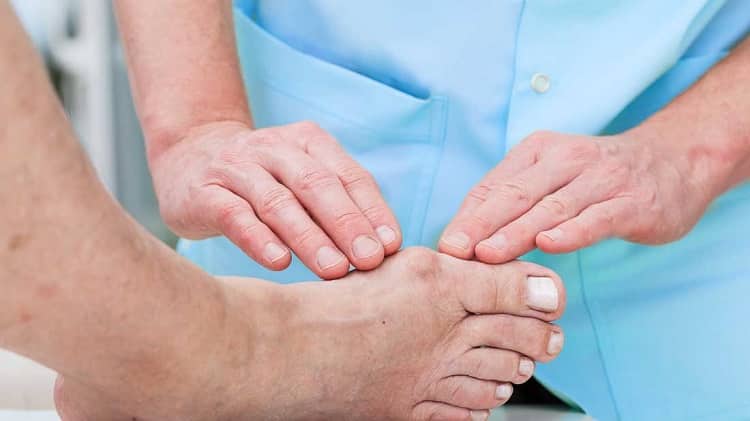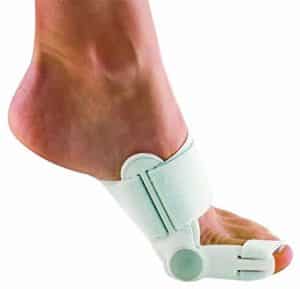
Pain in the big toe (Pain in the big toe)
Pain in the big toe can hit everyone, but especially hit those who strain the foot for a long time. Big toe pain and big toe pain can affect everyday life and work. Big toe pain can be caused by osteoarthritis, hallux valgus, gout, nerve pain and / or dysfunction of the joints and muscles. Feel free to contact us on Facebook if you have any questions or input.
- Also read: Lopsided big toe? Are you affected by hallux valgus?
- Remember: If you have questions that are not covered by the article, then you can ask your question in the comments field (you will find it at the bottom of the article). We will then do our best to answer you within 24 hours.
The article is divided into the following subcategories:
Cause of big toe pain
Symptoms of big toe pain
Diagnostic list of possible diagnoses of big toe pain
Treatment of big toe pain
Exercises and training for big toe pain
Cause of big toe pain
The cause of pain is usually due to a combination of several things. It is often due to a mixture of osteoarthritis, tight and dysfunctional muscles and stiff joints. The most common cause of such pain is the tight leg muscles and overload of the big toe over time. You can read more about possible diagnoses later in the article.
Hallux valgus: A common cause of big toe pain
Prolonged overload, for example due to walking on hard surfaces in work and everyday life, can lead to a gradual change towards the big toe joint and lead to the characteristic 'skewed' shape of the toe. This is a typical symptom of hallux valgus. To prevent further development of this condition that affects the big toe joint, one can use so-called hallux valgus support og toe pullers.

- This is a deluxe version of a hallux valgus support. You can tap the image or here to read more about this support (opens in new window)
These measures lead to more correct strain on the big toe and thus slows the development of wear-related diagnoses such as hallux valgus.
Common cause of pain on the underside of the foot blade and towards the big toe: Tight muscles in the foot blade
Another very common reason for getting pain in the foot blade itself and further up towards the big toe is tight muscles in the foot blade and stiff joints in the foot itself. Regular stretching of the foot blade, in combination with exercise exercises and self-massage with trigger point balls (click here to read more) can be very effective for both prevention and symptom relief.
We strongly recommend that you stretch your calves and foot muscles regularly to prevent foot pain and symptoms - rolling the foot of a massage ball / trigger point ball (as shown above and here ) can also stimulate blood circulation to tight and sore foot muscle.
No accept pain in the toes and feet! Get them investigated.
Do not let toe pain become a part of your everyday life. Regardless of your situation, even if it is one with a lot of walking on hard surfaces or a lot of sedentary office work, it is so that you can always achieve better function than it is today. Our first recommendation for biomechanical pain is to seek out one of the three occupational groups that are publicly authorized through the health authorities:
- chiropractor
- manual therapist
- Physical therapist
Their public health authorization is a result of the authority's recognition of their extensive education and is a security for you as a patient and entails, among other things, several special benefits - such as protection through the Norwegian Patient Injury Compensation (NPE). It is a natural security to know that these occupational groups are registered in this scheme for patients - and we recommend, as mentioned, that one is investigated / treated by occupational groups with this associated scheme.
The first two occupational groups (chiropractor and manual therapist) also have the right to refer (to imaging diagnostics such as X-ray, MRI and CT - or referral to a rheumatologist or neurologist if needed for such an examination) and the right to report sick (may report sick if deemed necessary). Key words for improved musculoskeletal health mean more appropriate load in everyday life (ergonomic adjustment), generally more movement and less static sitting, as well as increased focus on regular exercise.
Symptoms of big toe pain
Symptoms and clinical presentations vary depending on the cause and diagnosis. For example, nerve pain due to local or distal (eg prolapse of the lower back with pressure against the S1 nerve root) may cause sharper pain and associated radiation down the leg. Osteoarthritis in combination with poor function in muscles and joints can often be experienced more as aching and gnawing pain - and in comparison, gout will often be accompanied by inflammatory symptoms such as reddish swelling, night pain and throbbing / throbbing pain.
List of diagnoses: Some possible diagnoses that can hurt the big toe
Arthritis (Arthritis) (arthritis can cause pain in the large joint if it is affected)
Osteoarthritis (Wear changes in the big toe can cause pain and pain)
Cuboid syndrome / subluxation (dysfunction in other parts of the foot can affect the big toe)
Freiberg's disease (Avascular necrosis of bone in the forefoot may indirectly cause pain to the big toe)
Sciatica (nerve pain from the back may refer to the symptoms and torment of the foot by nerve root affection of the S1 nerve root)
Joint locker in foot or ankle (often foot pain can be due to joint restrictions in foot and ankle - which can be treated manually)
Morton's neuroma (this nerve condition can lead to malfunction and indirectly cause big toe pain)
muscle Knots / Myalgia in the foot, ankle and leg:
Active trigger points will cause pain all the time from the muscle (eg foot blade and tight leg muscles)
Latent trigger points provides pain through pressure, activity and strain
Plantar fascite (this condition affecting the tendon plate below the foot may sometimes refer pain to the big toe)
Flatfoot / Pes Planus (Misalignment of the foot can cause increased strain on the big toe)
Prolapse of the lower back (as mentioned, nerve effects in the back can cause symptoms all the way down to the big toe - this can be radiation, tingling, itchy pain, numbness, power failure and changes in the sensitivity of the skin)
Spinal stenosis of the lower back (see 'lumbar prolapse')
Gout (characteristically strikes the big toe and can cause intense pain in combination with inflammatory reactions)
Pain in the big toe can be due to muscular tension, joint dysfunction (eg osteoarthritis or joint restrictions) and / or irritation of nearby nerves. Our advice is that you take care of the pain and do not "let it go". Start actively with self-measures and feel free to have the problem investigated by a clinician (preferably a publicly authorized professional group such as a chiropractor or manual therapist).
Treatment of big toe pain
There are many ways to treat this type of pain and it depends on what is the cause of the pain. You can divide the treatment of the big toe pain into the following subcategories:
- Self-treatment and prevention
- Professional treatment
Self-treatment: What can I do even against pain?
Self-treatment and own actions should be a cornerstone of any battle against pain. Regular self-massage (preferably with trigger point balls), stretching and exercises can make a big difference when it comes to relieving and preventing pain states.
1. General exercise, specific exercise and activity are recommended, but stay within the pain limit. Two walks a day of 20-40 minutes make good for the body and aching muscles.
2. Trigger point / massage balls we strongly recommend - they come in different sizes so you can hit well even on all parts of the body. There is no better self help than this! We recommend the following (click the image below) - which is a complete set of 5 trigger point / massage balls in different sizes:
3. Training: Specific training with training tricks of various opponents (such as this complete set of 6 knits of different resistance) can help you train strength and function. Knit training often involves more specific training, which in turn can lead to more effective injury prevention and pain reduction.
4. Pain Relief - Cooling: Biofreeze is a natural product that can relieve pain by cooling the area gently. Cooling is especially recommended when the pain is very severe. When they have calmed down then heat treatment is recommended - it is therefore advisable to have both cooling and heating available.
5. Pain Relief - Heating: Warming up tight muscles can increase blood circulation and reduce pain. We recommend the following reusable hot / cold gasket (click here to read more about it) - which can be used both for cooling (can be frozen) and for heating (can be heated in the microwave).
Recommended products for pain relief in pain
Biofreeze (Cold / cryotherapy)
Manual treatment: Clinically proven effect on osteoarthritis, plantar fascitis and metatarsalgia
A recent meta-study (Brantingham et al. 2012) showed that manipulation of plantar fascia and metatarsalgia gave symptomatic relief. Using this in conjunction with pressure wave therapy will give an even better effect, based on research. Indeed, Gerdesmeyer et al (2008) demonstrated that pressure wave therapy provides a significant statistically significant improvement when it comes to pain reduction, functional improvement, and quality of life after only as few as 3 treatments in patients with chronic plantar fascia.
Manual treatment of big toe pain
As mentioned earlier, both chiropractor and manual therapist are the occupational groups with the longest education and public authorization from the health authorities - that is why these therapists (including physiotherapists) see the majority of patients with muscle and joint ailments.
The main goal of all manual treatment is to reduce pain, promote general health and increased quality of life by restoring normal function in the musculoskeletal system and nervous system. In case of musculoskeletal disorders, the clinician will both treat the toes locally to reduce pain, reduce irritation and increase blood supply, as well as restore normal movement in areas affected by joint dysfunction - this can be e.g. foot, ankle, hip and pelvis. When choosing a treatment strategy for the individual patient, the publicly authorized clinician places emphasis on seeing the patient in a holistic context. If there is a suspicion that the pain is due to another disease, you will be referred for further examination.
Manual treatment (eg from a chiropractor or manual therapist) consists of a number of treatment methods where the therapist mainly uses the hands to restore normal function in joints, muscles, connective tissue and nervous system:
- Specific joint treatment
- Stretches
- Muscular techniques
- Neurological techniques
- Stabilizing exercise
- Exercises, advice and guidance
Exercises and training for big toe pain
Exercise and exercise play a key role in the treatment and prevention of all types of pain and ailments - including pain in the big toe. By training the foot, ankle, calf and hips, you can reduce the incorrect load on the big toe - which means that the injury has a greater chance of healing itself.
Here you will find an overview and list of exercises we have published in connection with the prevention, prevention and relief of pain in the toes, toe pain, stiff toes, osteoarthritis and other relevant diagnoses.
4 Exercises against Plattfoot (Pes Planus)
5 Exercises against Hallux Valgus (Leaning Big Toe)
7 Tips and Remedies for Foot Pain
RELATED PRODUCT / SELF-HELP: - Hallux Valgus Support
We have previously recommended this product in the article and we know that many have a good effect on it. It can be a good way to prevent further development of the hallux valgus damage condition. This can in many cases help against both acute and chronic pain.
Plagued with hallux valgus (crooked big toe) and / or bone growth (bunion) on the big toe? Then this can be part of the solution to your problem! With this you get a more correct load on the forefoot and big toe.
References:
- Brantingham, JW. Manipulative therapy for lower extremity conditions: update of a literature review. J Manipulative Physiol Ther. 2012 Feb;35(2):127-66. doi: 10.1016/j.jmpt.2012.01.001.
- Gerdesmeyer, L. Radial extracorporeal shock wave therapy is safe and effective in the treatment of chronic recalcitrant plantar fasciitis: results of a confirmatory randomized placebo-controlled multicenter study. Am J Sports Med. 2008 Nov; 36 (11): 2100-9. doi: 10.1177 / 0363546508324176. Epub 2008 Oct 1.
- Punnett, L. et al. A Conceptual Framework for Integrating Workplace Health Promotion and Occupational Ergonomics Programs. Public Health Rep. , 2009; 124 (Suppl 1): 16–25.
Frequently Asked Questions About Big Toe Pain:
Ask a question if you are wondering something in the comments section at the bottom of the article or contact us via social media.
- No questions here yet














Leave a reply
Want to join the discussion?Feel free to Contribute!